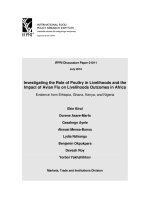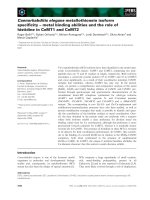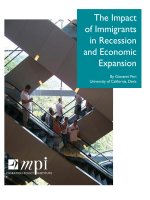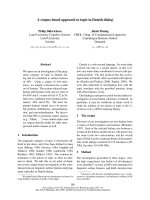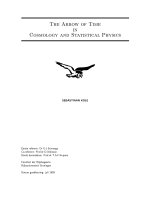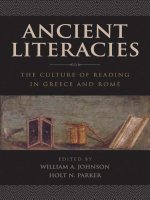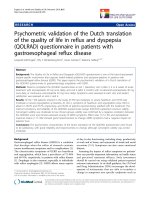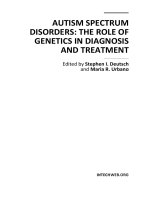The gulf of mexico oil spill a corpus based study of metaphors in british and american media discourse 1
Bạn đang xem bản rút gọn của tài liệu. Xem và tải ngay bản đầy đủ của tài liệu tại đây (981.64 KB, 20 trang )
1
CHAPTER 1
GENERAL OVERVIEW
1.1 Introduction
Language has not only been referred to as a “clear window”, but also
as a “refracting, structuring medium” (Fowler, 1991). This statement is
especially apt in the context of media discourse where ideologies abound
through the political stances and editorial perspectives adopted by the
respective owners and advertisers. This idea is clearly encapsulated by
Charteris-Black’s (2004) assertion that since political and media discourse aim
to offer an idealised vision of the social world according to the dominant
political viewpoint, metaphor choice is likely to be overt and intentional.
Furthermore, when language is consumed as a Bakhtinian chain of full texts,
the repetition of messages and message structures have a “habituating effect”,
causing ideas to become normalised, eventually affecting the social attitudes
and beliefs shared both by the audience and the producers of the mass media
(Hodges & Nilep, 2007).
According to Conceptual Metaphor Theory (Lakoff & Johnson, 1980),
metaphor shapes the people’s responses and perceptions. Each metaphor
highlights selected perceptions of reality and ignores others, thereby causing
one to focus on the desired consequences of favoured representations or
policies as determined by the parties in power. In other words, each metaphor
can be manipulated as a subtle way of highlighting what those in positions of
power want the masses to believe while avoiding inconvenient facts that they
2
do not wish to face. Thus, metaphors used by successful political leaders
exploit both conscious and unconscious emotional associations in order to
project particularly compelling representations of the speakers themselves or
the nations/groups they lead and can be seen as an “engine for language
change” (Charteris-Black, 2004, p.3). Chilton (1996) goes as far as to refer to
metaphor as a “constitutive part of thought and society” as metaphorical
thought is a universal property of the mind where abstract ideas are
represented in an experientialist framework for purposes of communication
and understanding (p.39).
This research focuses on the metaphorical framing of the Gulf of
Mexico Oil Spill that transpired from April 20 to July 28, 2010 in both
American and British Online Newspaper Discourse. In other words, a
discourse-analytical approach that is interdisciplinary and encompasses the
linguistic, conceptual and socio-cultural is mooted (Steen, 2010, p.49). This
research aims to examine the evaluative stance of the issues and actors
involved in framing a conflict between traditionally staunch allies. The
assumption is that this evaluative stance will be manifested through the
metaphors conveyed in the analysis. This thesis is inspired by Hardie, Koller,
Rayson and Semino’s (2007) research in exploiting a Semantic Annotation
Tool found within WMatrix (Rayson, 2008) for metaphor analysis. In other
words, this thesis aims to further describe and proposes to further modify the
exploitation of integrated online concordancing tools for the systematic
identification of metaphorical patterns in large datasets through the use of a
new framework for metaphorical analysis. This can be seen as an attempt to
potentially extend and triangulate intuition-based manual analysis and the
3
concordancing of pre-selected search strings as a basis for discourse-analytical
metaphor studies such as those carried out by Krennmayr (2011), Semino
(2002, 2004, 2008, 2010, 2011), Koller et al. (2008), Hardie et al. (2007),
Baker (2006), Bednarek (2006), Deignan (2005), Charteris-Black (2004,
2005), Musolff (2004a; 2004b), Cameron and Low (2003), Partington (1998)
and Chilton (1996, 2004).
Hence, this thesis aims to build on the existing cognitive-linguistic
approach to metaphor advocated by Lakoff & Johnson, and re-situate it in a
more encompassing theoretical framework that takes these three inter-related
aspects into account (Steen, 2011, p.27):
1. A novel adaptation of the linguistic approach (Pragglejaz
Group, 2007; Krennmayr, 2011)
2. The cognitive approach via conceptual structures e.g. cross-
domain mappings (Kovecses, 2011)
3. The communicative/social approach (Chilton, 1996, 2004;
Charteris-Black 2004; 2005; Mulsolff, 2004a; 2004b)
This will be done through the in-depth semi-automated analysis of a
representative newspaper corpus via the use of a new proposed framework for
metaphor identification and analysis.
4
1.2 Research Objectives
The methodology adopted in this thesis amalgamates the corpus
linguistic approach with conceptual metaphor theory and critical discourse
analysis. This means that the use of a representative corpus in tandem with
concordances and its relevant statistical correlations and frequencies are used
as an empirical platform for the further analysis of the relations between
entities, social meaning and discourse. This is due to the fact that many recent
studies have shown that the systematic analysis of metaphorical patterns in
naturally occurring and representative data “raises further questions and leads
to further insights into metaphor as a linguistic and cognitive phenomenon”
(Hardie et al., 2007, p.2). This thesis aims to extend existing corpus
methodology in the examination of conceptual metaphors in large datasets
through the use of two separate integrated online concordancing platforms.
This methodology involves the use of semantic annotations in WMatrix
software (Rayson, 2008) and the use of the Word Sketch function in Sketch
Engine (Kilgarriff et al., 2004) in a procedure referred to as the Integrated-
Approach to the Identification of Conceptual Metaphors (IICM). This
new proposed methodology has the potential to expand the identification and
analysis of conceptual metaphors beyond the premise of manual intuition and
pre-determined search strings. At this juncture, it is important to acknowledge
that earlier studies that utilise intensive manual analysis of representative data
have made significant contributions to the advancement of discourse-based
metaphor studies – and remain valuable and lauded references in the field.
However this new proposed methodology potentially enables the field to move
5
towards the “scalable investigation of open-ended sets of metaphoric
expressions” (Koller et al., 2008).
The key proposed advantage of this discourse-analytical framework is
that it is likely to be more productive than traditional methods of metaphor
analysis and provides an inductive, empirical springboard to the mining of
metaphors in a large representative data-set. Hardie et al. (2007) assert that
their preliminary research shows that this method “yields two to three times
more analysis than manual analysis” and that it is “no more time-consuming
than a purely manual analysis” (p.11). Finally, this thesis also aims to add to a
growing body of research on metaphor in actual contexts of use in a genre-
specific comparative study.
1.3 Background: The Gulf of Mexico Oil Spill (20 April – 28 July
2010)
Beyond Petroleum (BP PLC) is a British international oil and gas
company based in London. Founded in 1908, BP operates in more than 80
countries across six continents, providing its customers “with fuel for
transportation, energy for heat and light, retail services and petrochemicals
products” (BP, 2012). It is the third largest oil company in the world, with
83,400 employees worldwide as of December 2011, sales of $375,517 million
in 2011 and a market value, even after the recent losses, of more than $100
billion. It is has a market capitalization of £81.4 billion and is the fourth
largest company in the world listed on the London Stock Exchange as of 6
July 2012. It has branded itself as “Beyond Petroleum”, an environmentally
6
conscious energy company that aims to “work in ways that will benefit
communities and habitats and earn the world’s respect” by identifying and
growing low-carbon businesses (BP, 2012). However, its image and its future
financial prospects have been negatively impacted by the oil spill in the Gulf
of Mexico caused by the explosion of the Deepwater Horizon, a drilling rig
leased by BP on April 20, 2010. A rupture in a pipe a mile into the sea spewed
an estimated five million barrels of oil, making it “the largest accidental oil
spill in history” (Project for Excellence in Journalism, 2010).
According to research by the Project for Excellence in Journalism
(2010) (henceforth PEJ), most disasters covered by the media generate an
initial significant burst of media attention before dropping out of the headlines.
But the Gulf of Mexico Oil Spill was a disaster that captured the public’s
attention and far exceeded the usual media attention span. From April 20 to
July 28, the Gulf of Mexico Oil Spill dominated every other story in the
mainstream media in terms of salience and frequency. It accounted for 22% of
the news covered in America, dwarfing the coverage of the next most salient
issue, the economy at 12%. Furthermore, the Gulf saga registered as the
number one story in the mainstream news agenda in nine of those fourteen
weeks—and it never fell out of the top three (PEJ, 2010).
According to PEJ (2010), the coverage of the key storylines examined the
following:
1. The environmental and economic impact of the spill
2. The examination of BP’s role and responsibility in the disaster
3. The US government’s actions and responses during the crisis—with
much of the focus on the Obama administration
7
The narrative in the press focused on BP’s culpability in the spill as well as the
way its executives responded to the aftermath. BP’s lack of transparency in its
estimates of the damage, the attitude of its then-CEO, Tony Hayward as well
as its immediate responses to the needs of the Gulf residents accounted for
most of the negative media coverage. Other legal repercussions as a result of
these measures included a 50% loss in value of BP shares, the initiation of
possible criminal and civil charges against BP pertaining to the spill, the
resignation of Tony Hayward as BP’s chief executive and the promotion of his
subsequent replacement, American Robert Dudley.
It is important to note that this thesis is meant as a synchronic analysis
or a snapshot of the metaphorical evaluation of the Gulf of Mexico Oil Spill as
expressed through American and British media discourse. This is due to the
specific timeframe of the disaster in 2010, ranging from April 20, the day the
Deepwater Horizon oil rig exploded, to July 28, the day BP CEO; Tony
Hayward’s departure was announced. Online newspaper articles were
collected from 20 April up till 31
December 2010 in order to capture the full
range of metaphorical sentiments expressed pertaining to this disaster during
this period. This was because the event was viewed as one of the most
significant events in 2010.
1.4 Data Collection: The Broadsheets
In order to investigate the range of metaphors and the metaphoricity of
the texts, 250 separate articles directly related to the BP Oil Spill in the Gulf of
Mexico were collected from each online newspaper database. These articles
8
came from electronic versions of the respective newspapers collected from
Factiva between 21 April and 31
December 2010. Even though the oil spill
was fully capped on 28 July, newspaper articles were collected till 31
December in order to fully capture the entire range of sentiments pertaining to
the oil spill as it was widely viewed as one of the most significant events in
2010. The corpus collection was carried out by utilizing the Boolean search
function on Factiva where all instances of the keywords containing “BP” or
“Beyond Petroleum” and “Gulf of Mexico” or “Deepwater Horizon” were
identified and surfaced in a chronological listing (see Fig. 1.1-1.6). In a
procedure that is similar to Bednarek’s (2006) selection process for the
analysis of evaluation in newspaper discourse, articles were eliminated if the
key words within them were incidental and peripheral instead of being central
to the topic itself. Newspaper Headlines, the Deck (secondary headline
containing additional information on the story), Captions (under key
photographs related to the oil spill) and the textual content were collected for
further metaphorical analysis. As such, due to the extensiveness and reliability
of the Factiva search engine for each broadsheet, the corpus sample is of
sufficient size, breadth and synchronic range to identify metaphors and
conceptual metaphors used throughout the duration of the disaster. Hence, the
corpus collection process involves a selected cross-section of all oil spill
stories from 21 April through to 31 December 2010. The news stories were
considered to be oil spill stories if 50% or more of the story was on that topic.
9
Fig.1.1
Screen Shot for Search Builder on Factiva: ‘Guardian‘
Fig.1.2
Screen Shot of search results on Factiva: ‘Guardian‘
Fig. 1.3
Screen Shot for Search Builder on Factiva: ‘New York Times‘
10
Fig. 1.4
Screen Shot of search results on Factiva: ‘New York Times‘
Fig. 1.5
Screen Shot of search results on Factiva: ‘Washington Post‘
11
Fig. 1.6
Screen Shot of search results on Factiva: ‘The Daily Telegraph‘
1.4.1 The Corpus
Even though British and American broadsheets are seen as “the fourth
estate”, where the newspaper owners and advertisers are, in principle, free
from government interference, it is important to note that news proprietors
have the “power to influence the content, the political stance and the editorial
perspective of the paper” through the appointment of senior editorial staff. The
proprietors also tend to exercise their rights to “greater or lesser degrees”
(Bednarek, 2006, p.13). Hence, the metaphorical evaluation carried out in this
thesis aims to capture the effect that differing cultural perspectives and
political affiliations assert on the use of metaphor. It is important to note that
while the range of metaphors obtained from these 250 articles per broadsheet
might not be wholly encompassing, I believe that this preliminary aggregate
12
metaphorical analysis done via the IICM-framework surfaces the relevant
evaluative trends pertaining to the issue under study.
The corpus for analysis consists of a total of 250 news stories EACH
taken from FOUR established British and American national broadsheets
sourced from Factiva. From the British perspective, 250 articles were collected
from the Guardian out of a possible 598 for a liberal perspective. Another 250
articles were collected from the Telegraph out of a possible 870 for a
conservative viewpoint. From the American perspective, 250 articles were
collected from New York Times out of a possible 713 for a distinctive liberal
stance whilst another separate 250 articles were collected from the
Washington Post out of 519 articles for a conservative stance. A quick
overview of the four sets of corpora can be seen in the screen capture below
(Fig. 1.7).
Fig. 1.7
Screen Shot of the four corpora on Sketch Engine: An Overview
Articles were collected from Britain and America respectively in order
to capture the effect that differing cultural perspectives assert on the use of
metaphor. The subject matter was kept constant for the necessary
establishment of a comparable corpus. The scale of the selected topic, the Gulf
of Mexico Oil Spill by BP, was deemed to be central to society as it was
13
significant enough to be covered in all available newspapers and online
broadsheets for the entire duration of the disaster and beyond.
1.4.2. The American Broadsheets (New York Times & Washington Post)
The New York Times (NYT) is a prime candidate for this research for
several reasons, with the key factor being the sheer size of its readership.
According to the NYT company website, it has over 30 million unique visitors
in December 2011 making it the most visited online newspaper website, with
more than twice the number of unique visitors as the next most popular site.
The NYT Company also labels itself as a leading global, multimedia news and
information company with 2011 revenues of $2.3 billion with the core purpose
of enhancing society by creating, collecting and distributing high-quality
news, information and entertainment. The NYT is continuing to make the
change from “an enterprise that is operated mainly in print to one that is
increasingly multiplatform in delivery and global in reach” (NYT, 2012). The
NYT Company, owns a total of 18 newspapers, 8 television stations, more than
50 websites and two radio stations. This tremendous corporate presence allows
the NYT an almost unlimited amount of resources for gathering and reporting
the news. It has 27 bureaus within the US and 26 foreign news bureaus. The
NYT has won 108 Pulitzer Prizes, the most of any news organization and is
long regarded as the “newspaper of record” within the industry. It is also
known for its overtly liberal political stance in its reporting of key issues and
ideas.
For the purpose of comparison, 250 articles were also collected from
14
the Washington Post (WP). The Washington Post is owned by the Washington
Post Company, a diversified education and media company whose principal
operations include educational services, newspaper print and online
publishing, television broadcasting and cable television systems (Washington
Post Company, 2012). The WP is a very different newspaper from the NYT
due to its overtly conservative stance. It hails itself as a “uniquely independent
voice in journalism”. The Washington Post is Washington D.C.’s largest
newspaper and its oldest, founded in 1877. Located in the capital of the United
States, the WP has a particular emphasis on national politics. The WP has won
25 Pulitzer Prizes since 1991, more than half of the paper's total collection of
47 Pulitzers awarded. This includes six separate Pulitzers awarded in 2008, the
second-highest record of Pulitzers ever given to a single newspaper in one
year. The WP is generally regarded among the leading daily American
newspapers,
along with the NYT. It has one of the highest market-penetration
rates of any metropolitan news daily and is one of a few U.S. newspapers with
foreign bureaus located in Baghdad, Beijing, Berlin, Bogota, Islamabad,
Jerusalem, Johannesburg, Kabul, London, Mexico City, Moscow, Nairobi,
New Delhi, Paris and Tokyo. According to Wikipedia, the WP's editorial
positions on foreign policy and economic issues have seen a definitively
conservative bent in the way it has steadfastly supported the 2003 invasion of
Iraq, warmed to President George W. Bush’s policy to partially privatize
Social Security, opposed a deadline for U.S. withdrawal from the Iraq War,
and advocated free trade agreements.
15
1.4.3. The British Broadsheets (The Guardian & The Daily Telegraph)
The Guardian, founded as the Manchester Guardian in 1821, is a
British national daily newspaper known for its social liberal political stance. In
the last United Kingdom elections, the paper supported the Liberal Democrats
who went on to form a coalition government with the conservatives.
According to its website, The Guardian has the second largest online
readership of any British newspaper. The Guardian publishes all their news
online, with free access both to current news and an archive of three million
stories. In the 1990s, in the midst of the price war amongst the other
broadsheets, The Guardian remained at full price, “investing resources in
journalism and distancing itself from the price war through distinctive and
innovative marketing, product development and consistently breaking big
stories” (The Guardian, 2012). As of January 2011, it is the most popular UK
newspaper site, generating almost 37 million unique users each month, with
12.6 million unique users within Britain itself. In 2007 the newspaper was
ranked first in a study conducted by the International Center for Media and the
Public Agenda of the University of Maryland in terms of transparency. The
Guardian was awarded the National Newspaper of the Year in 1999, 2006 and
2011 by the British Press Awards in addition to garnering the accolade as the
co-winner of the World's Best-designed Newspaper in 2006. The Guardian
Media Group uses a diverse portfolio of investments to deliver the financial
security that allows it to achieve its central objective – which is the editorial
independence of the Guardian in perpetuity (The Guardian, 2012).
16
In contrast, The Daily Telegraph, founded in 1855, is a daily morning
broadsheet distributed throughout the United Kingdom and internationally
(The Telegraph, 2012; Wikipedia, 2012). The Telegraph Online is the online
version of the newspaper. It includes the articles from the print editions of The
Daily Telegraph and The Sunday Telegraph as well as web-only content such
as breaking news, features, picture galleries and blogs. It was named the UK
Consumer Website of the Year in 2007 and 2009 by the Association of Online
Publishers. In the 2010 British Press Awards, it was awarded the “National
Newspaper of the Year” for its coverage of the MP’s expenses scandal. The
Telegraph Online became the most popular UK newspaper site in April 2008
before being overtaken by The Guardian in April 2009. As of 2010, it is now
the third most visited British newspaper website, with most of its traffic from
social media sites. The Daily Telegraph has been politically conservative in
modern times due to the personal links between the paper's editors, the
leadership of the Conservative Party and the Conservative Activists. Thus, this
contrast in the respective political leanings within each online broadsheet
provides an additional dimension for analysis for this research paper.
1.5. Aims and scope of the current study
This thesis aims to examine the following aspects of metaphorical
framings pertaining to the oil spill:
• What conceptual metaphors occur in the discourse of the BP Oil Spill?
17
• What metaphorical concepts of the oil spill and the relevant entities
(BP, the American & British Governments, the Oil itself etc.) were
contested in the national and international discourses?
• Which metaphorical concepts of the oil spill and the relevant entities
have been established in debate and how do they compete with one
another?
• How do the aggregate metaphorical evaluations inherent within the
respective conservative and liberal broadsheets impose their own
concepts on the readers?
• What similarities and differences are there between the metaphors and
Conceptual Metaphors identified in liberal and conservative US online
broadsheet discourse and the UK broadsheet discourse?
• What explanation is there for the similarities and differences?
• How can the use of integrated online concordancing platforms
(specifically a semi-automated semantic annotation tool and word
sketches of a word’s grammatical and collocational behaviour) be
applied systematically, inductively and (potentially) exhaustively in
order to establish the conceptual metaphors that structure our
understanding of the BP Oil Spill?
1.6. Significance of the study
The methodological shortcomings associated with the formulation and
analysis of conceptual metaphors have been extensively documented by a
range of metaphor scholars (Krennmayr, 2011; Steen, 2011; 2009; 2007;
18
Kovecses, 2010; Semino, 2008; Pragglejaz Group, 2007; Hardie et al., 2007;
Deignan, 2005a; Musolff, 2004a; 2004b; Cameron & Low, 2003; Partington,
1998; and Chilton, 1996). Deignan (2005a) goes even further by stating that
even large representative corpora provide limited usefulness in the study of
innovative metaphor due to the inevitability of researcher bias as the
researcher can only uncover what he/she sets out to look for through the use of
“pre-determined search strings”. Hence, in an attempt to systematise the use of
“pre-determined search strings” which potentially incorporate a high degree of
researcher bias in the analysis of the corpus data and to minimize missing out
on large chunks of relevant and possibly significant lexical items in the
process, the selection of lexical items for analysis in this thesis is based on the
empirical suggestion of candidate semantic fields proposed by USAS,
embedded within the WMatrix web-based concordancing programme. The
resultant lexical item for analysis is thus empirically suggested by an
integrated concordancing platform (in accordance to the corresponding Log-
Likelihood values and frequency counts). The process of conceptual metaphor
formulation is augmented by the use of a systematically documented
framework, aided by the “word sketch” function that provides collocational
frequencies for empirical selection in Sketch Engine (henceforth, SkE), to be
used in tandem with an established corpus-based dictionary for the
establishment of systematicity. This proposed method of analysis is potentially
more productive and generates a set of inductively-generated metaphors in a
departure from the use of pre-determined search strings. The eventual
refinement of such a framework through subsequent iterations can potentially
result in a common platform for future discourse on metaphors.
19
Thus, this thesis aims to build on existing developments in conceptual
metaphor theory and corpus methodologies to suggest a new framework for
the inductive, systematised analysis of a large representative corpus for
metaphors. This research aims to provide a preliminary glimpse into the
metaphors used in the BP Oil Spill discourse and to determine the concepts of
the oil spill that were contested in the national and international discourses.
This will be done through the use of a combination of automatic semantic
analysis, key word identification and domain techniques. While this proposed
framework is broadly inspired by Hardie et al. (2007), it contains significant
departures from the original methodology. Hence, the Integrated-approach
to the Identification of Conceptual Metaphors (IICM) can be seen as a
new methodology for the computer-assisted analysis of metaphorical patterns
in discourse for large collections of representative texts.
1.7. Structure of the thesis
The rest of the paper is organised as follows: Chapter 2 introduces a
range of literature pertaining to Conceptual Metaphor Theory and the
significant milestones from its inception in 1980 till this day. It also provides
the theoretical springboard for the development of the Integrated-Approach
to the Identification of Conceptual Metaphors (IICM) in Chapter 3.
Chapters 4, 5 and 6 will comprise an in-depth preliminary analysis of the
conceptual metaphors inherent within each broadsheet. Specifically, Chapter 4
will examine the range of metaphors generated from the American
Perspective, namely from the New York Times (NYT) and Washington Post
20
(WP). Chapter 5 will be doing the same from the British perspective,
encompassing the aggregate view of metaphors from The Guardian (G) and
The Daily Telegraph (TT). Chapter 6 will embody the comparative approach
whilst Chapter 7 concludes the paper with an in-depth discussion and the
preliminary evaluation of the entire issue (based on the scope of the corpora)
as well as the areas for further research.

